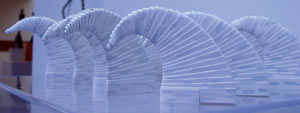Touching Herds: Les Bohnenkamp at the Tweed Museum
The Tweed Museum exhibits Les Bohnenkamps Spirals in Space and Time through February. Tweed Museum, on the campus of University of Minnesota-Duluth at 10 University Circle.

Throughout the gallery, congregations of coiled, colored creatures stand silently. These herds of odd, conical paper sculptures attest to the tireless hands of their creator—the hands of a weaver, a maker of all things that entice touch.
“Spirals in Space and Time,” at the Tweed through February, traces the career of the late Les Bohnenkamp (1943-97). Born in Iowa, the artist studied textile design at the University of Iowa before embarking on a career in New York. His success there stemmed from his remarkable ability to translate the materials and techniques of traditional craft into sculpture.
“Spirals” displays samples from each phase of Bohnenkamp’s career, nicely documenting his evolution as an artist. Most engaging and beautiful are his “herds,” groupings of ten to fifteen impeccably crafted, identically painted paper sculptures. Each consists of a rolled piece of paper, its outer edge creating a winding surface spiral. Their bent or curled pointy tops and applied color (ranging from eggplant purple to green stripes) convey each group’s distinct personality.
“Gold Herd with Mother” features a large upright sculpture and eight smaller ones. The large piece’s swanlike profile and beakish tip transform the abstract piece into a mother bird leading her young. Finished with metallic paint, the birds seem robotlike, sporting golden exoskeletons, like the flock that would frequent Robocop’s birdbath. Quirky and magnificent, they possess an indescribable vitality, curiously animate while solemnly static.
Less compelling but still impressive are Bohnenkamp’s large fiber sculptures. Their sheer size and near-obsessive intricacy are astounding. These jagged, pointy totems resemble upside-down icicles dressed in brown sweaters. Silently imposing, they dwarf the herds below, threatening to crush their paper world.
A smaller crocheted piece achieves a more personal, humorous effect. “Stones” consists of 12 cushy crocheted spheres of varying size. The balls sit piled in a corner, a cozy lump of multi-tonal brown horsehair with whispers of gray. Though soft and tempting to touch, they elicit a slew of hilarious references due to their color and shape. (Think of what you might clean out of the cage of a large, crocheted rabbit.) Bohnenkamp’s humor emerges as testimony to the pleasure he found in making art.
Fate cruelly robbed Bohnenkamp of that pleasure in 1980, when a car hit the artist as he crossed a street in New York. He survived and continued to work for almost a decade, but the effects of his injuries surfaced in the late 1980s, causing the once-prolific artist to stop working. He died in 1997, at just 54 years old.
Artists and critics have recognized Bohnenkamp’s vision more fully since his death. In 2000, the Joseph Rickards Gallery in New York exhibited “Spirals,” extending the show’s run due to its popularity. The Tweed now exhibits the show due largely to Duluth artist Bill Shipley. As Bohnenkamp’s collaborator, friend and lifetime partner, Shipley’s efforts have kept Bohnenkamp’s artwork in public view since his death.
In a career spanning just two decades, Bohnenkamp discovered and exposed the elegance of pedestrian materials and redefined the possibilities of paper and thread. “Spirals” honors this accomplishment and the innovative mind and hard-working hands behind it.
This article first appeared in the Ripsaw News, and appears here by permission.